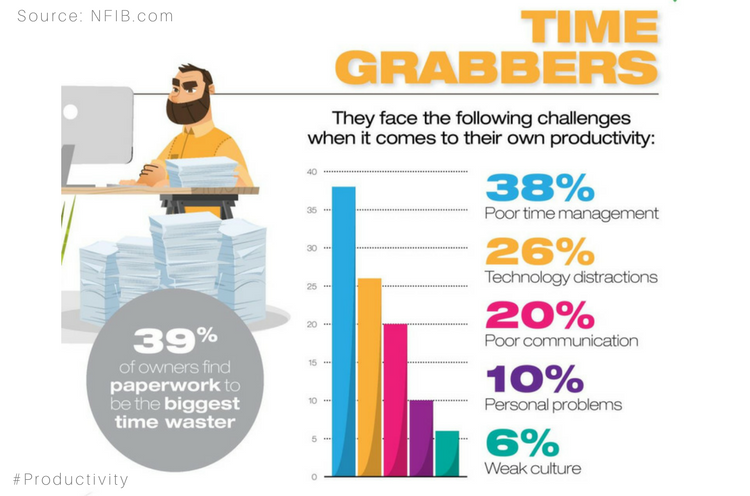Being productive when you don’t feel like it? Yeah, that’s tricky. You're not always going…

Why Small Business Owners Struggle With Productivity (And How to Fix It)
Are you experiencing small business productivity problems? Running a business, leading a team, and accomplishing priorities can be difficult.
As a small business owner, you do a lot, don’t you? You vet ideas, meet with your team, and look for ways to improve your product or service in addition to all the daily tasks you have on your list. If you’re floundering and struggling with productivity problems, know that you’re not alone. It’s not uncommon.
Today’s post is all about three of the main reasons small business owners struggle to improve their productivity — and a simple tool they can use to fix it for good.
3 Small Business Productivity Problems You Must Fix
Not to be a Debbie Downer, but, it’s helpful to know what the pitfalls are so that you can avoid them (and yes, there are many). What should you look out for? What’s the key reason small business owners struggle? Two words: Time management.
What exactly does that mean? We all have the same 24 hours in the day, right? For a small business owner like you who has multiple hats to wear and just one body for those hats, those 24 hours can be tricky. And, sometimes painful when you lose clients or leads.
When you focus on the wrong things at the wrong time, nothing seems to fall into place. You get agitated and that enthusiasm you may have once started out with goes missing in action. Almost out of nowhere. In fact, it might now be replaced by tension, stress, and overwhelm because things are starting to fall through the cracks.
Poor time management can take several forms. Here are three ways it can rear its ugly head.
1. Productivity Problem: Getting Distracted
Do you find yourself getting overwhelmed or distracted at certain times of the day? Do you wonder where all your time goes even though you’re always busy?
If you don’t have a productive structure or plan in place for your day, it will be very easy to get stuck in a rabbit hole (or two). They can take the form of bottomless e-mail boxes, unnecessary meetings, TikTok videos, pings and dings from your smartphone, a cluttered workspace, and more.
Another culprit that halts your productivity is multitasking. It’s another type of distraction that fools you into believing that you’re getting a lot done when all you’re doing is switching from tasks to task.
All of these (and more) can impact everyone in your organization if you allow them to.
(can you picture your collective productivity falling to the floor?)
Why Small Business Owners Struggle With Productivity (And How to Fix It) Share on X2. Productivity Problem: Missing Deadlines
With distractions at every turn, your focus can get pulled in all the wrong directions and you’re bound to miss project milestones, lose out on high-quality leads, or forget an important touch point with your most valuable clients. You might even find yourself arriving late to meetings that you are hosting.
The stress that comes with missed deadlines and opportunities can negatively color your day and stop your productivity in its tracks.
3. Productivity Problem: Doing It All
If you have an assistant or a team and you still you still attempt to do it all, you might start to notice the negative impact not only on how you feel mentally and physically, but also on how your team members might feel.
Annoyed, frustrated, and overwhelm are a few emotions they might feel, especially if you often:
- give in to the urge to micromanage
- say yes to every new project that lands on your desk
- attempt to solve problems that are best handled by someone else
“Doing it all” might also be a symptom of just not knowing what your true priorities are and how to select them from your to-do list. This can be especially tricky when you have competing tasks and everything seems urgent and important.

What Do All These Productivity Problems Add Up To?
Are you allowing time-grabbers to sabotage your day and sap your energy? Take a moment to think about the cumulative effect of doing this every day. It adds up. And not in your favor.
Here’s a formula to consider:
Getting Distracted + Missing Deadlines + Doing Everything = Frustration & Failure
You know how painful this feels. You become more stressed and feel on edge all the time when you don’t get the outcome you want. As a result, your conversations with your team and even family members will probably start feeling like mini-battles.
You might try to “make up” for this lack of productivity by skipping family time and by working longer days and on the weekends. This means you’ll have less time to do things you really love and no time to recharge so you can focus on improving your business.
And, it only gets worse from there. Overworking leads to burn out and can push you to throw the towel in. You’ll simply give up and, what’s more, you’ll no longer have the drive or desire to do much of anything.
But, you don’t have to let things get that far. There is a solution, a better formula — one that you can start using immediately to right the ship and get back on course.
Why Small Business Owners With Teams Struggle & How to Fix It
RaPiD Productivity Can Help
As as a Certified Professional Organizer® and productivity consultant, I’ve worked with many solopreneurs and business owners who couldn’t figure out where all their time went each day. They were always busy but the problem was that they had nothing to show for it — no real productive results or accomplishments.
And all of them wanted to:
- Take back control of their time and set up their ideal workday.
- Get things done without having to follow a complex set of rules.
- Enjoy life and spend time doing anything (or nothing).
Essentially, they needed a unique productivity formula customized just for them so that it aligned with their brain and work style. The problem was that they didn’t know where or how to start.
So, I developed RaPiD Productivity, an easy-to-implement, 3-step process to help small business owners focus on the right thigs at the right time:
- Review
- Plan
- Do
These 3 steps can be used to quickly identify the time zombies that eat up your productive minutes, and to create a strategic daily plan to stave off distractions so you focus on the right things at the right time.
How Can RaPiD Productivity Help You?
How do I know RaPiD Productivity works? Well, I’ve also used it myself.
I’ve pivoted a few times in my company. With each change, a new set of challenges and distractions often popped up.
During those times, I’ve used RaPiD Productivity to:
- Figure out my time sucks *this is where the time tracking worksheet comes in (more below)
- Create my unique productivity formula
- Come up with my ideal work schedule based on my energy
- Find the right tech tools to get things done
And, as someone who really loves apps, it can be easy to take my eye off the prize and chase after the newest shiny thing. Sometimes I let all my interesting and creative ideas run wild which can make it difficult to figure out what to do next.
(that’s when things really get overwhelming and my productivity can plummet)
RaPiD Productivity has helped me to move in the right direction without over-taxing my brain cells or messing with my family time.
Download The Time Tracking Worksheet to Boost Your Productivity
The first step in RaPiD Productivity is to figure out *exactly* what you give your attention to and for how long. That’s were the RaPiD Time Tracking Worksheet comes in.
It is a key component of my productivity system you can use to track your time and jumpstart your productivity.
Step 1: TRACK YOUR TIME (3-7 DAYS)
The beauty of the worksheet is in its simplicity. It’s straight forward and easy to use. Use it for 3-7 days to get a true sense of how you spend each day.
(not enough time? use it for 1 day to get a snapshot)
To complete the worksheet, record:
- Tasks or MITs you normally work on every day (projects, recurring tasks and meetings)
- Tasks that pop up out unexpectedly (unscheduled meetings, interruptions)
- How much time each task takes (start and end times)
ℹ Note: Let’s talk if you have questions or get stuck, and I’ll help walk you through it.
Step 2: cREATE YOUR UNIQUE PRODUCTIVITY FORMULA
Once you’ve completed your time audit and you know where your time is going, you will learn:
- How long it typically takes you to complete specific to-do’s (so you can plan better)
- What your bottlenecks and time sucks are (so you can avoid them or use them strategically)
Armed with this information, you can then create a productivity formula (including your ideal work schedule) to turn things around. Be sure to sprinkle in productivity methods to support your new plan and watch your productivity soar.
Simple. Easy. Doable.
Isn’t time for you to take back control of your time and kiss those small business productivity problems goodbye? Ready to close the door on distractions and start meeting those deadlines without piling more on your plate?
Create a custom productivity formula that’s just right for you.
Take the first step by downloading my free time tracking worksheet. Click the blue button to get it now.
Download: Time Tracking Worksheet (free)
Ready to Transform Your Productivity and Succeed as a Solopreneur?
Dive deeper into the strategies discussed in this post and get comprehensive guidance in my course, “How to Become a Successful Solopreneur: Leverage Tech Tools for Maximum Productivity and Profit.” Learn proven techniques to leverage technology, create your unique productivity formula, master time and energy management, and achieve your business goals with confidence.
Join the waitlist today to be the first to know when enrollment opens!
Empower yourself with tech tools and knowledge to thrive in your solopreneur journey. Don’t miss out—secure your spot and take the next step towards entrepreneurial success. 🚀




Your comment about not micromanaging the team is really resonating with me today. I worked with a client recently who had left her job because she felt micromanaged by her boss. In fact, everyone in the office was apparently feeling the same way, knowing that whatever they wrote or did, the boss would redo it. The situation was very de-motivating and a productivity-killer. After all, why work hard if you know that it will be redone? Giving your team some trust and opportunity to try/fail is very important.
That’s a tough one, Seana. When the business is your baby, sometimes it’s hard to let go of some things and trust that your team can handle their responsibilities.
But, then on the flipside, it’s a huge time suck when you micromanage and you’ll tick off your employees. Two words: No bueno. Did your client ever tell her employer (even during an exit interview) how she felt?
This sentence really jumped out for me: “When you focus on the wrong things at the wrong time, nothing seems to fall into place.”
People often talk about doing the right things and the right time, but turning it around shows the impact. I’ve often got caught up in something because it was important – but it didn’t need to be dealt with at that moment.
I generally manage to avoid getting distracted by things I see online, by adding them to Pocket. Once a week I’ll go there to read what I’ve saved and share as appropriate. (That said, my Pocket list is getting kind of long – again!)
You’re right, Janet — some things may be important but don’t need your attention at that time. The tricky part is negotiating with yourself because you feel like working on them anyway. LOL 😉
And, thanks for reminding me to check my Pocket. I haven’t cleaned it out in a while! =O
I love your idea of RaPiD Productivity! I’ve pivoted 3 times in my 25+ year business. And restructuring and modifying tasks and priorities take some time but can be done. The more I evolve my business, the more I find that my productivity is more effective because I know what not to do. Thanks for sharing your expertise.
I love your description of the evolution of your business and of yourself. Those 25 years have given you lots of lessons on how to get the best out of yourself. Knowing what to avoid is just as important as knowing what to focus on. Awesome sauce! Thanks for sharing, Sabrina.
I love how you identified the three top time-grabbers! #3- Doing It All resonates with me. I’m doing better at delegating and assessing when it makes sense NOT to do the “thing.” I use my timer to help me focus. So I will allow some ‘wander’ time during my day but typically work in short, focused increments.
I also love how you developed a Productivity Formula with a time-tracking worksheet. You are amazing, Deb!
Thanks for the kind words, my friend! 😊 I love that you have “wander” time, Linda. It gives your brain a break from “all the things” and lets you be creative. It’s seems like it’s a built-in reward for you and helps keep you balanced.
Falling into the category of knowing what you should do but failing to do it, I do try to do it all because I’m terrible at delegating. I’m frugal, so I don’t want to pay for support if I know I can do it reasonably well myself, and even when I had staff, I have trust issues. But you can’t eschew the importance of prioritizing those MITs and focusing your unique energy there. All of your points are so apt!
My wish for you is that you don’t continue to do everything by yourself. And I believe you can still be frugal and get help. 😊 Delegation is an art and so is accepting help when it’s offered (that last one is my Achilles’ heel at times). Glad that you stopped by, Julie!